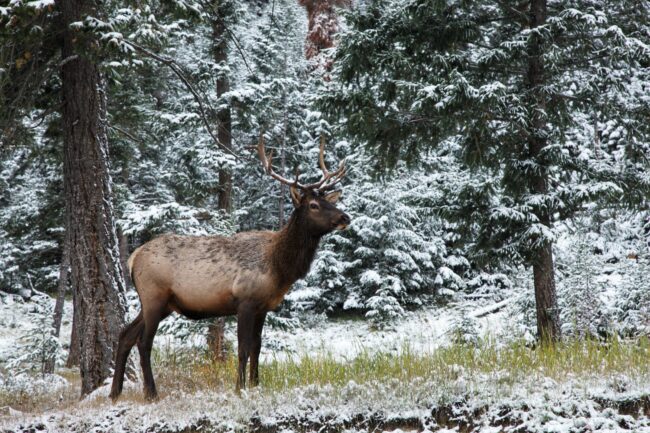Table of Contents
Who wouldn’t like to be tucked in and stay cozy in the harsh winters? Sadly, deers don’t have that luxury. White-tailed deer, the deer species seen throughout the United States, rely on adaptations, biological elements, and behavioral changes to survive winter.
Biological Elements
Due to the positioning of their eyes, the deer’s field of view is 310 degrees. Deer also see ultraviolet light in two colors. Their enhanced vision comes from the deer’s eyes as they are present near the side of their head. Thereby enabling them to observe the entire panorama. For example, lichens appear black in the eyes of deer in North America.
How Do Deer Survive The Winter?
How does their body react?
The nose of deer is full of many small blood vessels that transport the red blood cells to discharge oxygen into the tissues that need it most. In the winter, the highly vascularized nose of the deer regulates the temperature of their brains. The nose acts as ventilation to the brain.
The blood vessels are filled and emptied to a rhythmic flow that had never been observed before. The vascularization further helps heat the air that enters the body. This makes it easier for deer to emit their sounds as they warm the air that comes in, to prevent throat damage.
Digging for food
Deer use their antlers to dig for food in the winter. The plants that deer normally eat fall on the ground and are buried. Covered by the snow, these plants may perish by freezing on the ground.
Hence, deer must find the plants quickly by the use of their antlers. During the winter, the pads on their feet harden, becoming like an ice pick. They are used to cutting snow surfaces and keeping them steady on their feet. They also use their hooves to excavate food buried under snow.
Due to their large bodies, deer directly correlate the heart rate and their temperature. Under extreme conditions, deer lower their heart rate and temperature to conserve energy. Their heart rate is 65 beats per minute in spring and lowers to 40 beats per minute in winter.
Behavioral Changes
They begin shedding summer fur coats in fall to allow for a winter coat. The fur in a deer’s winter coat consists of thicker, longer, and darker hair called guard hair while also growing in a thicker undercoat. Furthermore, it is hollow, which allows air to be trapped. The air makes body heat retention easier; a white-tail deer’s temperature is 104. Hence, they do not feel the cold from the snow.
In addition, they have special muscles to help them adjust the angle of their hair for maximum insulation. Furthermore, you will observe a deer’s color change from a red-brown hue to a grey-brown one in winter. It is because the darker or deeper shade helps them in absorption of more of the sun’s heat to warm themselves even more.
As a result of this winter coat, their skin produces an oil that makes their fur water repellent. Hence, their fur has protection against cold and snow.
Suitable timing adjustments
Deer herd-up and roam more while it is daylight to conserve the energy they need to control their body temperature. They shelter in areas near food sources that provide more cover. In extreme conditions, they sometimes stay in place for days and rely on their fat stores to survive.
They reduce their activity in winter. This allows them to eat less and conserve energy. These areas, known as “deer yards,” may encompass many acres providing shelter for deer.
Furthermore, these areas have nearby southern-facing slopes where they can absorb the sun’s heat on sunny days. In preparation, they add extra fat to their bodies to insulate against the cold properly. They consume five to nine pounds of food each day to build their body fat. Deer draw on this fat reserve to supplement food consumption.
Grouping to survive
Whitetails also begin to accumulate in groups in the winter months. They search for the same type of wintering area and find security in numbers. The higher the number of animals, the lower the chances of a predator selecting one.
In addition, there are obvious benefits of extra eyes, ears, and noses to detect approaching predators. Even the mature ones are known to spend much of the year in solitude.
Or, they do so with a larger group to live nearby during winter. In the northern areas, there are typically hundreds of herds. Especially in the later part of the winter season as well as during the early spring season when the food sources are limited.
Diet Changes
Deer continue their usual diet in winter while mixing nuts, berries, and mushrooms. These foods contain more calories that allow them to store more energy. One of their top food sources is woody browse. The woody vegetation type depends on their area, but good examples are eastern hemlock, aspen seedlings, and Canada yew.
Conclusion
These animals have multiple ways as well as adaptations that can aid them in surviving the winter season. The ways that these creatures have developed to survive the winter season are in fact, a part of their evolution. It has occurred not just in a jiffy but over a million years.
These species have great natural and creative ways to cope with climate change.

